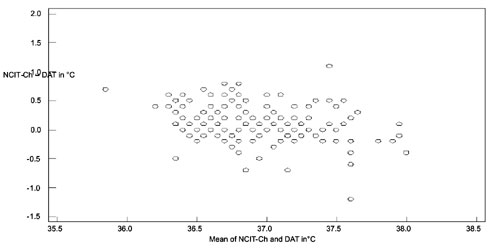|
|
|
Indian Pediatr 2018;55: 609- 610 |
 |
Comparison of
Non-contact Infrared Temperature with Digital Axillary
Temperature
|
|
Varghese Abraham*, Elizabeth Johnson and Khristina Deep
Christian Hospital, Chhatarpur, Madhya Pradesh, India.
Email:
[email protected]
|
We measured the Non-contact infrared temperature
(NCIT) from the forehead, chest and abdomen, and compared it with
Digital axillary temperature (DAT) by Bland Altman Plot. The DAT agreed
better with NCIT chest (mean difference 0.13, 95% limit of agreement
0.08, 0.18) as compared to NCIT forehead and abdomen.
Keywords: Fever; Measurement; Thermometry.
|
|
I
nfrared thermometry is a quick
and non-invasive method of recording temperature [1]. Forehead is
considered to be the preferred site for temperature measurement by
Infrared thermometers [2,3], but the evidence-base to support this site
is lacking.
This prospective study was done in neonates admitted
in the Special Newborn Care Unit (SNCU) of Christian Hospital,
Chhatarpur, Madhya Pradesh, India. The study was approved by the
Institutional Ethics Committee of Emmanual Hospital Association (EHA).
After obtaining informed consent from parents, a trained nurse measured
digital axillary temperature (DAT) and non-contact infrared temperature
(NCIT) from the forehead, chest and abdomen within a span of 6 minutes.
Multifunctional Infrared thermometer PC808 and Omron Digital Thermometer
(Model MC-246) was used in the study. The temperature recordings were
obtained from neonates nursed under overhead warmer as well as from
those who were nursed in a cot by the mother’s side. The warmer was
servo-controlled with temperature set at 36.5°C and the room temperature
was set between 26-30°C. DAT was compared with the NCIT from forehead,
chest and abdomen. The data were entered in Microsoft excel sheet and
analyzed by Bland Altman graph [4].
We measured 211 sets of temperature recordings from a
conveniently selected sample of 30 neonates over a period of 20 days.
The mean (SD) values of DAT, NCIT forehead, NCIT chest and NCIT abdomen
were 36.9 (0.48), 36.6 (0.24), 37.0 (0.41) and 37.1 (0.42),
respectively. The DAT agreed better with NCIT chest (mean difference
0.13, 95% limit of agreement 0.08, 0.18) as compared to NCIT forehead
and abdomen (Table I) (Fig. 1).
TABLE I Agreement of DAT with NCIT at Various Sites (N=211)
|
Comparison |
Mean difference (95% limit of agreement) |
|
DAT vs NCIT Abdomen |
0.22 (0.17 to 0.27) |
|
DAT vs NCIT Chest |
0.13 (0.08 to 0.18) |
|
DAT vs NCIT Forehead |
-0.32 (-0.38 to -0.25) |
|
DAT: digital axillary temperature; NCIT: Non-contact
infrared temperature. |
 |
|
Fig. 1 Bland Altman plot for
Non-contact infrared temperature (NCIT) chest and Digital
axillary temperature (DAT).
|
According to the manufacturer’s manual for
Multifunctional Infrared thermometer PC808 and the American Society for
Testing and Materials standard specifications, the NCIT should be used
in the mid-forehead [2,3]. Chiappini, et al. [3] stated forehead
NCIT to be the best to measure core body temperature because of the
proximity to the temporal artery and is more convienient when the baby
is dressed up. Sethi, et al. [5] also observed that NCIT forehead
do not agree well with DAT in neonates.
We suggest the use of NCIT chest in neonates as it
agrees well with the DAT as compared to NCIT forehead and abdomen.
Acknowledgement: Mrs Wendy Mills MSc.
Registered Paediatric Nurse Practitioner in the UK.
Funding: None; Competing interest: None
stated.
References
1. El-Radhi AS. Determining fever in children: The
search for an ideal thermometer. Br J Nurs. 2014;23:91-4.
2. ASTM E1965 - 98(2009) Standard Specification for
Infrared Thermometers for Intermittent Determination of Patient
Temperature. Available from: http://www. astm.org/Standards/E1965.htm.
Accessed September 22, 2016.
3. Chiappini E, Sollai S, Longhi R, Morandini L,
Laghi A, Osio CE, et al. Performance of non-contact infrared
thermometer for detecting febrile children in hospital and ambulatory
settings. J Clin Nurs. 2011;20:1311-8.
4. Bland JM, Altman DG. Statistical methods for
assessing agreement between two methods of clinical measurement. Lancet.
1986;1(8476):307-10.
5. Sethi A, Patel D, Nimbalkar A, Phatak A,
Nimbalkar S. Comparison of forehead infrared thermometry with axillary
digital thermometry in neonates. Indian Pediatr. 2013;50:1153-4.
|
|
|
 |
|

